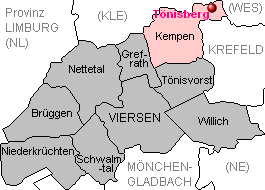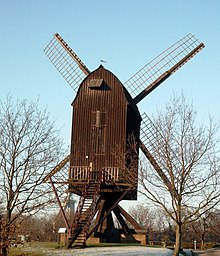Tönisberg
|
Tönisberg
City of Kempen
|
|
|---|---|
| Coordinates: 51 ° 24 ′ 49 ″ N , 6 ° 30 ′ 18 ″ E | |
| Height : | 31 m above sea level NN |
| Area : | 9.37 km² |
| Residents : | 3339 (Dec 2005) |
| Population density : | 356 inhabitants / km² |
| Incorporation : | January 1, 1970 |
| Postal code : | 47906 |
| Area code : | 02845 |
|
Tönisberg in the city of Kempen and in the district of Viersen
|
|
Tönisberg is a district of the city of Kempen on the left Lower Rhine in the district of Viersen in the west of North Rhine-Westphalia with around 3400 inhabitants . The next larger cities in the vicinity are Neukirchen-Vluyn , Krefeld , Moers and Duisburg .
The name Tönisberg derives on the one hand from Saint Antonius Abbas ( Sanct Antonis Bergh ) and on the other hand from the Mühlenberg, on which the village is located.
geology
Tönisberg is embedded in a glacial valley , bounded by a terminal moraine that runs in east-west direction as the southern end of the Lower Rhine ridge . The northern ice sheet reached up to this terminal moraine - the Mühlenberg - in the Saale Ice Age. For this reason, types of rock can be found here that are otherwise only found in Scandinavian countries. The Geldern Fleuth flows on the western side of the mountain .
Expansion and neighboring communities
The area of the district in the district of Viersen borders in the south on the area of the independent city of Krefeld , in the southwest on the Kempen district of St. Hubert (district Viersen), in the west on Stenden in the municipality of Kerken , in the north on Schaephuysen in the municipality of Rheurdt ( both district of Kleve ) and in the east to the Neukirchen-Vluyns area ( district of Wesel ) and is therefore exactly on the border of the Wesel, Kleve and Viersen districts.
Around the Tönisberg town center, clockwise from the north, are the farming communities Neufeld, Achterberg, Siebenhäuser, Vinnbrück and Haag, as well as the former colliery settlement of Wartsberg.
history
Tönisberg was first mentioned around 1284 with a treaty of Vennebrugge (today Vinnbrück ) in the run-up to the Battle of Worringen . The settlement of the actual village began with the establishment of a chapel in 1437. Mainly it was farms that shaped the image of the village. In 1529 the district around the chapel became an independent parish and the construction of its own church began. From 1794 to 1814 Tönisberg was under French rule . In 1800 Tönisberg was assigned to the municipality of Kempen . This then changed under the Prussian rule , in which a separate mayor's office was established.
Around 1900 there were 960 inhabitants in Tönisberg. Further development was made more difficult by the location as a quasi- enclave in the Moers district and the poor connection to Kempen. The most important project for the settlement of industry and commerce was the construction of an acetylene gas factory for the maintenance of street lamps . When it was commissioned in 1904, it was the only production facility in the region. However, the triumphant advance of the supply of electricity led to competitive pressure, financial bottlenecks and finally to the cessation of production around 1916.
Electricity prevailed and in 1913 advice was given about connecting Tönisberg to an electric tram line and an omnibus line . However, due to the geographical disadvantages of the location, this project was rejected again. In 1929, as part of the municipal reorganization , the part that had previously belonged to Schaphuysen was incorporated into the rural community of Tönisberg. On March 3, 1945, during Operation Grenade, a combat group from the 5th US Armored Division captured Tönisberg; this ended there the Nazi era and World War II .
Shaft IV of the Niederberg mine was in operation from 1962 to 2001 as a transport and weather shaft and was then backfilled . The winding tower still shapes the townscape today; it is the westernmost winding tower in the Ruhr area .
As part of the district area reforms , Tönisberg became a district of Kempen on January 1, 1970.
dialect
“Berger Platt” is spoken in Tönisberg . The Kempen district is located in the Lower Franconian dialect area north of the so-called Benrath line (with the maache-maake distinction), which separates southern Central Franconian (also called Ripuarian ) from northern Lower Franconian . Tönisberg is also north of the Uerdinger dialect line , which comes from the Rhine and runs past Hüls via Kempen to Venlo. This Uerdingen line (also called ek-ech border) separates the southern Lower Franconian (which is spoken in Uerdingen and Krefeld, for example) from the northern Lower Franconian , which z. B. in Tönisberg, in Hüls (see Hölsch Plott ), St. Hubert and Kempen and north of them on the Lower Rhine.
One of the main differences is the pronunciation of the personal pronoun "I", which is spoken as "ech" or "isch" in southern Lower Franconia, but as "ek" in northern Lower Franconia. The word “also” is also pronounced differently, namely as “ook” in northern Lower Franconia and as “ooch” in southern Lower Franconia. The verb “have” is also spoken differently: in Tönisberg one says z. B. "we häbbe". Further south it says “we hant”. The dialect is on the decline; it is cultivated at carnival, on dialect evenings and in clubs. There is also a lot of vernacular literature.
coat of arms
The coat of arms of the former independent community has only been in use since 1955 and shows Saint Anthony (Abbas) - the patron saint against epidemics in humans and animals - with a pig in the lower area and a medlar flower in the upper left - the Geldrische rose as a sign of former affiliation with Bailiwick of Geldern.
education
- Municipal community elementary school Tönisberg
- Municipal kindergarten
- Catholic kindergarten
Attractions
In addition to the box-frame windmill , which was completed in 1802, the Catholic parish church of St. Antonius from 1894 with a 47 m high tower and the winding tower of the Niederberg mine (shaft IV) are the landmarks of the village. In the center of the village there is also Haus Baaken , a building from the early 17th century that has now housed a small ceramic museum. The place took part in the competition Our village should be more beautiful several times . Coming from the direction of Hüls / Krefeld, at the foot of the Tönisberger Heights, there is a memorial to the Treaty of Vinnbrück , which was decided there in 1284 and which had an impact on the Battle of Worringen in 1288.
economy
Two large food processing companies as well as small and medium-sized companies are based in Tönisberg.
Infrastructure
Tönisberg is on the federal motorway 40 , which is the connection to Venlo ( Netherlands ) and Duisburg / Ruhr area. The Kerken junction (with the exit to Bundesstraße 9 ) is located in the Tönisberg area. The federal road 9 provides the connection to Krefeld . Tönisberg operate four bus routes that connect to Krefeld, Neukirchen-Vluyn , Kamp-Lintfort , Kerken and Kempen . Tönisberg does not serve a railway line.
- 065 (SWK) Tönisberg Moränenstrasse – Kempen train station
- 076 (DB) Krefeld Hbf – Kamp-Lintfort New Town Hall
- 077 (DB) Krefeld Hbf – Rheurdt Oermterberg
- 079 (DB) Krefeld Hbf – Aldekerk station
The SWK bus route "065" is operated by the subcontractor Rath-Reisen GmbH from Viersen. The DB bus routes are mainly served by the subcontractor Schlotmann from Moers.
Personalities
The agricultural entrepreneur Hans Tenhaeff (1879–1955) and the writer Gerhard Schulte (1875–1951) were born in Tönisberg.
The ceramist Anneliese Langenbach (1926–2008) lived and worked in Tönisberg from 1963 to 1989 . Many monuments as well as the portraits of the foot drop stations in Tönisberg come from her.
The Turkish actor Hilmi Sözer grew up in Tönisberg until the end of his school days. The writer Sebastian Ingenhoff lets his novella play here.
Web links
Individual evidence
- ^ Rudolf Roth: The Tönisberg acetylene gas factory around 1900 . Ed .: Heimatverein Tönisberg eV, Kempen 2000.
- ↑ Hans Kaiser: The last battles in the region. rp-online.de , March 16, 2015, accessed on August 10, 2018 .
- ↑ Martin Bünermann: The communities of the first reorganization program in North Rhine-Westphalia . Deutscher Gemeindeverlag, Cologne 1970, p. 114 .
- ↑ on a branch path in a bend in the B9
- ^ Margret Vieregge: Anneliese Langenbach on her 80th birthday on February 9, 2008 . In: Tönisberger Heimatblätter 8/2006, pp. 49–51.
- ↑ Margret Vieregge: The village that lies behind the mountain. Rheinische Post, July 20, 2015, accessed on October 9, 2017 .



